JOHN HANSON WAS THE 8TH PRESIDENT OF THE CONTINENTAL CONGRESS BUT THE 1ST PRESIDENT
UNDER THE ARTICLES OF CONFEDERATION AND PERPETUAL UNION. HE WAS FOLLOWED BY 6 PRESIDENTS UNTIL 1-YEAR TERM LIMITS WERE ABOLISHED BY WASHINGTON'S TOP SECRET "CONSTITUTION." |
A total of 14 Presidents served in the Continental Congress:
1. PEYTON RANDOLPH |
2. HENRY MIDDLETON |
3. JOHN HANCOCK |
4. HENRY LAURENS |
|---|---|---|---|
5. JOHN JAY |
6. SAMUEL HUNTINGTON |
7. THOMAS MCKEAN |
8. JOHN HANSON |
9. ELIAS BOUDINOT |
10. THOMAS MIFFLIN |
11. RICHARD HENRY LEE |
12. NATHANIEL GORHAM |
13. ARTHUR ST. CLAIR |
14. CYRUS GRIFFIN |
Canon lawyer John Jay was the author of the New York State and Washington's top secret "Constitution." Colonel John Laurens—aide-de-camp to George Washington—was the eldest son of Henry Laurens. Duelist Alexander Hamilton volunteered to act as a second when he challenged General Charles Lee to a duel.
Arthur St. Clair was determined to block the western expansion of the New Jerusalem at any cost. In March 1791, assisted by Alexander McKee and Simon McGirty, he led a massacre of U.S. soldiers and pioneers in the Northwest Territory. "St. Clair's Defeat" led to the deaths of over 600 U.S. soldiers, and the massacre and scalping of countless pioneers! Naturally, he never faced a court martial for the greatest defeat of U.S. soldiers by native Americans.
Thomas Mifflin and Nathaniel Gorham were also delegates to the top secret 'Constitutional" Convention.
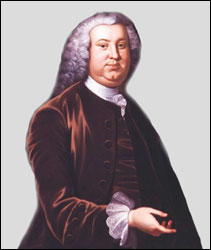 Peyton Randolph (1721–1775). First President of the Continental Congress. |
|
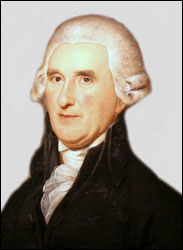 Thomas McKean (1734–1817). Last President before the Articles of Confederation. |
The first Constitution, called the Articles of Confederation, was drafted in 1777, and ratified on February 2, 1781. The "surrender" of Lord Cornwallis at Yorktown did not happen until October 19, 1781... It was amazingly prescient of the Continental Congress anticipate a British "surrender" before it happened!
No power was granted to the Continental Congress to tax the people, and the Presidential term was limited to 1 year:
The United States in Congress assembled may appoint a president who shall not serve longer than one year per three-year term of the Congress. (Articles of Confederation and Perpetual Union, Article IX).
Congressmen were limited to a 3-year term with the all-important term limits applied to them as well as the President.
 John Hanson (1721–1783). First President under the Articles of Confederation. |
|
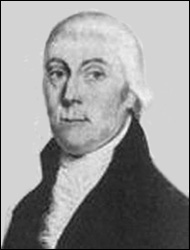 Cyrus Griffin (1784–1810). Last President under the Articles of Confederation. |
The position of 1-year term Presidents was abolished when Cyrus Griffin's term ended on November 2, 1788, because the new top secret "Constitution" was already ratified on June 21, 1788.
The first Constitution, or Articles of Confederation, prohibited any changes or alterations . . . unless ratified by the 13 states:
Every State shall abide by the determinations of the United States, in Congress assembled, on all questions which, by this consideration are submitted to them. And the articles of this confederation shall be inviolably observed by every State, and the union shall be perpetual; nor shall any alterations at any time hereafter be made in any of them, unless such alterations be agreed to in a Congress of the Unites States, and be afterward confirmed by the legislatures of every state. (Articles of Confederation and Perpetual Union, Article, XIII).
On May 25, 1787, delegates met in Philadelphia to "revise" the Articles of Confederation....Instead of "revising" the Articles, a completely new "Constitution" was drafted. All the delegates were sworn to secrecy, and George Washington dominated the Convention delegates like Emperor Jesus Constantine at the Council of Nicaea.
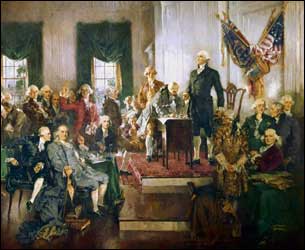 Signing the "Constitution," Independence Hall, Philadelphia, September 17, 1787. Signing the "Constitution," Independence Hall, Philadelphia, September 17, 1787. |
|
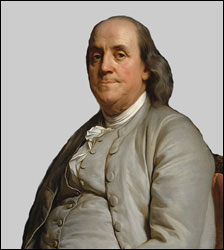
Benjamin Franklin
(1706–1790). |
The top secret Constitution was submitted to state CONVENTIONS for ratification on September 28, 1787, and ratified by 9 state CONVENTIONS on June 21, 1788. No state LEGISLATURE ratified the top secret "Constitution."
The new "Constitution" was a blueprint for tyranny because no mention was made of term limits for Presidents, Senators, Congressmen and judges! In the Roman SPQR Republic, consuls were limited to 1 year in office because the people knew by experience that men hate to relinquish power once in office!
The first section dealt with the all-important power to tax the people directly, because, without money to bribe his opponents and pay his army, no dictator or king can tyrannize the people:
The Congress shall have Power To lay and collect Taxes, Duties, Imposts and Excises, to pay the Debts and provide for the common Defence and general Welfare of the United States; but all Duties, Imposts and Excises shall be uniform throughout the United States (Washington's "Constitution," Article I, Section VIII).
The second section dealt with the Office of the President, and nothing was mentioned about term limits:
The executive Power shall be vested in a President of the United States of America. He shall hold his Office during the Term of four Years, and, together with the Vice President, chosen for the same Term, be elected, as follows (Washington's "Constitution," Article II, Section I).
When Governor Patrick Henry first read the new "Constitution" he was astonished and alarmed....As a lawyer he was very familiar with the Articles of Confederation, but the new "Constitution" was a radically different document.
He realized that it was a TWIN of the British aristocratic governing system, with the President as king; the Senate as the House of Lords, and Congress as the House of Commons!
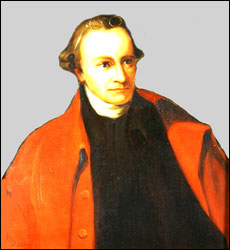
Virginia Governor Patrick Henry
(1736–1799). |
|

New York Governor George Clinton (1739–1812).
|
Because of the extreme secrecy, Robert Yates and John Lansing Jr. soon left the Convention in disgust, but duelist Alexander Hamilton remained behind.
Patrick Henry—a true spiritual heir of Saint Patrick—was the real Father of the country because he fathered a total of 17 children....Despite all the efforts of Governor Henry and liberty-loving people, the "Constitution" was ratified by the required 9 states on June 21, 1788.
The 13 state legislatures took 26 months to ratify the Bill of Rights!!
It only took 9 months for the required 9 state CONVENTIONS to ratify Washington's new "Constitution." Congress sent that "Constitution" to the state CONVENTIONS for ratification on September 28, 1787, and it was ratified by the required 9 state CONVENTIONS on June 21, 1788. No state legislature ratified the top secret "Constitution."
Under the new "Constitution," George Washington was appointed President, and John Adams was appointed Vice President. Washington commenced reigning on April 30, 1789.
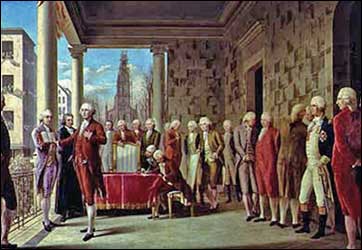 Washington's first inaugural in Federal Hall, Washington's first inaugural in Federal Hall, New York City, on April 30, 1789. |
|
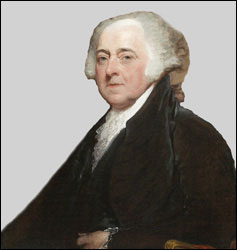 John Adams (1735–1826) was the first Vice President. |
The conspirators did allow for Amendments to Washington's "Constitution," but they approved 2 methods of ratification: LEGISLATURES OR CONVENTIONS:
The Congress, whenever two thirds of both Houses shall deem it necessary, shall propose Amendments to this Constitution, or, on the Application of the Legislatures of two thirds of the several States, shall call a Convention for proposing Amendments, which, in either Case, shall be valid to all Intents and Purposes, as Part of this Constitution, when ratified by the Legislatures of three fourths of the several States, or by Conventions in three fourths thereof, as the one or the other Mode of Ratification may be proposed by the Congress; Provided that no Amendment which may be made prior to the Year One thousand eight hundred and eight shall in any Manner affect the first and fourth Clauses in the Ninth Section of the first Article; and that no State, without its Consent, shall be deprived of its equal Suffrage in the Senate. (Washington's "Constitution," Article V).
When the conspirators wanted a speedy and rubber stamped ratification they chose CONVENTIONS....When they wanted to abort or slow down the ratification process they chose LEGISLATURES!
The perilous fight for a Bill of Rights could have lasted much longer because the state legislators had to agree on the WORDING and the number of Amendments. Miraculously, 10 Amendments were finally approved. The first Amendment guaranteed the all-important freedom of religion, speech, and the press:
Congress shall make no law respecting an establishment of religion, or prohibiting the free exercise thereof; or abridging the freedom of speech, or of the press; or the right of the people peaceably to assemble, and to petition the Government for a redress of grievances (Bill of Rights, First Amendment to the U.S. Constitution).
The second Amendment was inspired by Christians who were familiar with the Book of Esther and Haman's attempt to destroy all the Jews in the Persian Empire:
A well regulated Militia, being necessary to the security of a free State, the right of the people to keep and bear Arms, shall not be infringed (Second Amendment to the U.S. Constitution).
The 8 additional Amendments granted more rights to the people, and saved them from direct taxation, but no mention was made of the all-important terms limits for Presidents, Senators, Congressmen and judges.
Because of the lack of term limits, a DRUNK named "U.S." Grant was absolutely determined to serve for a third term. FDR was elected for a third term but he was assassinated before he could finish his term.
It was not until the ratification of the 22nd Amendment in 1951 that term limits were finally imposed on the President.
Vital links
References
Chorlton, Thomas Patrick. The First American Republic 1774–1789: The First Fourteen American Presidents Before Washington. AuthorHouse, Bloomington, Indiana, 2011. (Brief biographies of the first 14 Presidents).
Reardon, John J. Peyton Randolph: One Who Presided. North Carolina Academic Press, Durham, North Carolina, 1982. (It should be entitled: Peyton Randolph: The One Who Was Poisoned!).
McKean, David. Suspected of Independence: The Life of Thomas McKean. America's First Power Broker. PublicAffairs, New York, 2016.
Maier, Pauline. Ratification: The People Debate the Constitution, 1797-1788. Simon & Schuster, New York, 2010.
Smith, Seymour Wemyss. John Hanson, our First President. Brewer, Warren & Putnam, New York, 1932.
Copyright © 2022 by Patrick Scrivener